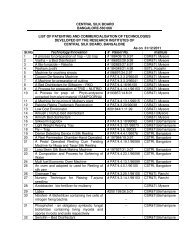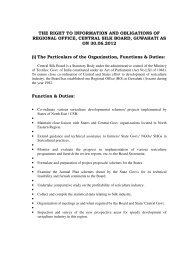RCS Section - Central Silk Board
RCS Section - Central Silk Board
RCS Section - Central Silk Board
You also want an ePaper? Increase the reach of your titles
YUMPU automatically turns print PDFs into web optimized ePapers that Google loves.
39<br />
40<br />
41<br />
42<br />
43<br />
44<br />
45<br />
Popularization of<br />
improved spinning<br />
machine<br />
Package of practices<br />
for Muga and eri<br />
based intercropping<br />
system<br />
Identification of two<br />
productive castor<br />
genotypes<br />
Protocol for<br />
vegetative<br />
propagation of host<br />
plants<br />
IPM against leaf<br />
gall<br />
Indoor chawki<br />
rearing technology<br />
Secondary nutrient<br />
combination SM5<br />
for increased leaf<br />
and cocoon yield<br />
46 BC-IV line of<br />
Andhra Local for<br />
higher productivity<br />
Popularized eri spinning machine among farmers<br />
through training and practicing at traditional<br />
farmers’ level. Increase in yarn realization &<br />
production of finer count to get higher productivity<br />
& return<br />
Demonstrated in farmers fields. It is in practice at<br />
certain private farmers’ level. Introduced Ginger,<br />
Turmeric and Colocasia as intercrops in Som and<br />
Kesseru plantation for enhancing farm income.<br />
Two productive castor genotypes have been<br />
identified and introduced in the farmers field to get<br />
higher leaf yield.<br />
The protocol enables raising of plantlets from stem<br />
cuttings with a success rate of about 80%. The<br />
system facilitates propagation of desired<br />
genotypes, which hitherto were propagated<br />
through seeds.<br />
This reduces the gall infestation and facilitates<br />
availability of quality leaf for silkworm rearing.<br />
Indoor rearing of the chawki worms (up<br />
to 2 nd moult) ensures development of healthy<br />
worms with higher survival<br />
The combination SM5 increased the quality leaf<br />
yield by 27.45% in T. arjuna and 26.55% in T.<br />
tomentosa over control with significant<br />
improvement in cocoon characters<br />
The improved line of the Andhra local ecorace<br />
developed through hybridization with Daba shows<br />
higher fecundity (230), cocoon yield (26<br />
cocoons/dfl) and filament length (802 m) over the<br />
Andhra local ecorace (fecundity: 190, Cocoon yield:<br />
6 cocoons/dfl, filament length : 662 m)<br />
29













